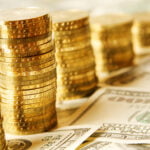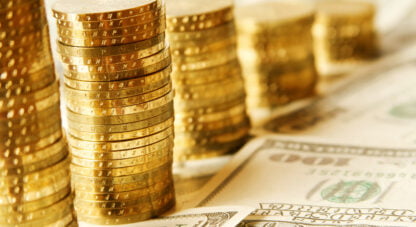View a Printable PDF Click Here
This month we welcomed the return to the Weekly Commentary of a guest with whom we do not always agree, but from whom we always learn much. Richard Duncan speaks clearly and insightfully on matters of great import. He agrees with us that our current economic system of “creditism,” as he calls it, has been an ill-advised departure from capitalism. His cure for the problem, however, could probably fairly be described as “hair of the dog….” To be fair, if I may take the liberty of synopsizing, he may be saying that we should not let the ideal get in the way of the practical when national survival is on the line.
Some 87 years ago, the economy of the United States tanked, leading to the Great Depression. Richard believes that the Fed’s failure to aggressively expand the money supply then was a major cause of the Depression. He believes that the U.S.’s different approach over the past eight years has, if not returned the patient to health, at least kept him from dying. So his prescription for a return to health is to stop using QE funds indiscriminately and start using them to rebuild America’s rotting infrastructure. Doing so, says he, will create millions of jobs, unleash pent-up creativity, and restore needed roads, bridges, airports, and much more.
As you can tell from the full length interview, found here, I’m not quite onboard. Clearly I am dealing with a leader and thinker who has done his homework, but, well, Richard’s description of economic Luddites – in which retrograde company he might well lump me – is, “So many bright and well-meaning people advocate balancing the budget, reducing the debt level, banning the Fed, but that’s just like someone who has gone up in a hot air balloon, far up in the sky, suddenly looking down and becoming frightened and advocating cutting off all the hot air. Well, our balloon has been inflated by massive amounts of credit for more than half a century. If you cut off the credit now, our hot air balloon is going to crash to the ground and we’re all going to die. So, we need to keep the credit flowing.”
I couldn’t help thinking to myself that a hot air balloon has only about two hours of fuel on board. If you go up and don’t manage your descent, you will still come down – and soon – and badly. Richard would doubtless say that his plan will bring us down safely, and perhaps he’s right. You be the judge. Here is an excerpt from the interview, in which he examines China and it’s probable need for massive credit creation in the future (a process it has already begun). The complete interview segues from this analysis of China’s full-on use of “hot air” into ours – past and future. I hope you have time to join us for the entire conversation. Again, you can find it here.
David: Richard, you’ve been thinking about and writing about the Chinese boom in your Macro Watch program, your excellent new video service. Things began to change in 1979 and there was a cooperative effort between the U.S. and China. We were interested in changing the relationship to some degree. Under Deng Xiaoping, they were, too. So, why don’t we start with the boom that we’ve seen, one of the greatest in world history? Where did that boom come from? Who financed it? Give us the genesis, if you will.
Richard: China has become the second-largest economy in the world. It is now almost 65% the size of the U.S. After the U.S. went into crisis in 2008, China stepped on the credit accelerator and starting pumping out more and more credit to drive its economy. China became the driver of global growth. So what’s going on in China is enormously important for the entire world, and for all of the financial assets within the world.
We’re told that last year China’s economy still grew at 6.9%. That’s the official number. That may or may not be the case, but what matters for the rest of the world is not how much China’s GDP is growing. What matters for the rest of the world is how much China’s imports are growing, how much more China is buying from the rest of the world every year. And last year China’s imports contracted by 17%, so China wasn’t a driver of global growth – just the opposite. It became a very big brake on global growth.
So, it seems that China’s hard landing has already started, and it started last year. It’s already having enormous global repercussions because, with China buying so much less, that’s why global commodity prices crashed last year. It’s why all of the commodity producing countries either had severe economic slowdowns or went into severe recession. Brazil, for instance, is in the worst depression it has experienced in 100 years and its currency has crashed. So what is going on in China is enormously important for everyone in the world.
China’s strategy for success was an economic development strategy based on export-led and investment-driven growth. Once the Berlin Wall came down, the United States stopped viewing China as an enemy and we started trading with China. We allowed it to sell more and more Chinese goods into the United States. In 1990 China’s trade surplus with the U.S. was zero. Last year it was a billion dollars a day – a 367 billion-dollar trade surplus that China had with the United States in one year. Between 1990 and now, China has racked up roughly a four trillion-dollar surplus on their current and financial accounts, so that’s where the core money came from. That’s where they got the money to develop their country.
This money went into their banking system. As with all modern banking systems, fractional reserve banking greatly expands the supply of money. Credit creates more credit, so they ended up with 20 trillion dollars of credit growth since 1990. With that credit growth, their level of investment increased by a factor of 50 between 1990 and 2014 – a 50-fold expansion of investment. China invested in things like factories, residential building, office towers, and all kinds of infrastructure.
So, we’ve hit the point now where the level of investment in China is far greater than the level of investment in the United States. In 2014, investment in China was 4.6 trillion dollars, whereas investment in the United States was only 3.2 trillion. So China is far out-investing the United States since 2008, and this has enormous repercussions from any angle you care to look at it.
David: So we’re really saying that the money came from the West, went to the East, was put into the banking system, and was multiplied by credit growth from four trillion to 20 trillion. That money enabled a 50-fold expansion in investment, and that investment enabled a boom in China’s manufacturing base for the development of roads and infrastructure, ultimately leading to what we have today, which is overcapacity. China has the ability to create almost anything, but in quantities that the world really can’t consume at this point.
Richard: That’s right. At this stage, China’s economy has become wildly unbalanced. They have so much more investment than they do consumption. For instance, in a normal Western developed economy consumption, personal consumption normally makes up something close to 70% of the entire economy. In the U.S., it’s 68% of GDP. (GDP is made up of personal consumption plus business investment plus government spending plus trade – exports minus imports. Those four things added together amount to 100% of GDP.) In China, however, personal consumption is only 38%.
In the United States, investment makes up only 18% of GDP, but in China it’s 44% of GDP. Honestly, probably not since the Pharaohs built the pyramids with slave labor has any country witnessed such a high level of investment to GDP and such a low level of consumption to GDP. China is investing and producing goods far above what its people can afford to consume. That was fine for a couple of decades. They just exported all the surplus to the rest of the world, primarily the United States. But in 2008 the U.S. went into crisis. Japan is in and out of recession, Europe is in and out of recession, the U.S. economy is weak, and not only are these countries not growing, they’re already saturated with Chinese imports. This is causing a growing political backlash around the world against free trade and against globalization, and quite a political upheaval.
One of the videos about China that I recently published was called “One World is not Enough,” because the world doesn’t have enough purchasing power to allow China to continue pursuing this strategy of export-led and investment-drive growth. At this stage, China has so much excess capacity that prices are falling for their industrial goods. Their corporations are increasingly loss-making. That means that the non-performing loans of banks that financed the investment are beginning to skyrocket, which essentially means that deposits in those banks are being destroyed.
What that means is that, at this stage, the more China invests, the more money it’s going to lose. That’s why China has hit a tipping point now, and that’s why it has tried to shift its economic growth strategy from one based on investment-driven growth to one based on consumption-driven growth. However, that’s very difficult because the consumption that China has now has resulted from its very high rates of investment over the last several decades.
If you begin laying off people working in the steel industry or coalmines, those people may be able to find jobs in the service sector. But as we’ve seen very clearly in the United States, service sector jobs tend to pay a lot less than manufacturing jobs do. So when you slow down on the investment, you don’t automatically speed up the consumption. It’s actually the opposite. You slow down the investment, you slow down the consumption, as well. So, China is now struggling, and its struggle is already beginning to hit the global economy.
Now, there are some really fascinating stories. One statistic that you may have heard is that in just three years, from 2011 to 2013, China produced as much cement as the United States did during the entire 20th century. That’s just mind-boggling. Think about that. If they do that for the next three years, then once again, of course, they will produce as much cement as the United States did in the entire 20th century. But that’s zero growth!
Here’s another story. I recently was in Seoul to take part in a conference called the Asian Leadership Conference. I was asked to go there to take part in a debate about China’s economic future. I was a bit worried, to tell you the truth, because normally I make speeches but I’m not asked to debate. The person on the other side of this debate was a well-respected Chinese professor from one of the more well-known Chinese universities. They asked me to make the negative case, and he was making the positive case. So I wasn’t quite sure what I was going to face, but honestly he didn’t put up much of a fight at all.
This is the story he told. He said he had recently been taken to one of the many large cities in the middle of China and his host showed him two recently completed bridges – very nice, big bridges. The thing is, these bridges, which were already completed, didn’t cross anything. The river was still planned. There was no river. These bridges went across a river that didn’t exist yet.
We hear of the ghost cities that have been built where no people live, all to keep the Chinese work force employed and happy, happy with the communist leadership and the communist party running the country. So, China is facing very serious challenges and it’s going to be enormously important for the rest of the world whether they succeed in preventing China’s economy from collapsing into a Great Depression kind of scenario.
Now, I think they will be able to avoid a Great Depression scenario in the same way that Japan has. Japan’s bubble popped 26 years ago, and Japan hasn’t had any growth, but they haven’t had a Great Depression either. The way they have managed that is through having very large amounts of government debt. Every year Japan has had a very, very large government budget deficit. That has taken Japan’s government debt from a ratio of debt-to-GDP of 60% of GDP in 1990 to 250% of GDP now. By borrowing and spending on a very aggressive level, Japan has managed to keep its economy from collapsing into a depression.
That’s probably what we’re going to see in China, as well. The only option really available to it will be for the central government to borrow and run very large budget deficits and keep the economy propped up that way. But even then, even if things go perfectly, it will be very difficult for them to manage to have 3% GDP growth a year going forward. Contrast that with the fact that, up until recently, almost everyone expected China to continue growing at least 7% or 8% a year, almost to infinity. So, this slowdown in China is going to change everything. Now, how are they going to respond to this crisis that they are confronting? What we have seen is, they have begun to devalue the currency.
The Chinese currency – it’s called the renminbi – has been pretty closely pegged to the U.S. dollar for a long time. Quite a few years back it started appreciating slowly against the dollar. That was as it should be because China has such an enormous trade surplus with the U.S. But back in August last year that all changed. The renminbi suddenly had a 2-3% devaluation, which really caused shock waves around the world. That’s because if China’s currency becomes weaker, all of China’s exports become more competitive against the exports of all its trading partners. It also means that China would have less purchasing power to buy things from the rest of the world.
That means commodity prices become weaker. If Chinese goods become cheaper, that exports deflation to the rest of the world. It also hits corporate profits – all the mining and metal and energy companies around the world. So the stock market also took a big hit on that news. At that point the Fed was actively discussing and preparing for increases in U.S. interest rates. The dollar was appreciating because the market expected the Fed to hike U.S. interest rates. And as the dollar appreciated, it pulled the renminbi up along with it, because the two were so closely pegged.
So, in August, this little devaluation in China was, I think, a warning from the Chinese that if the Fed hiked U.S. interest rates China would devalue. If China devalued significantly, that would export deflation to the United States, and last year we were verging on deflation anyway. That would make it impossible for the Fed to meet one of its mandates of close to 2% inflation. So it was a kind of Chinese blackmail, and I think this is probably the main reason that the Fed has not increased interest rates. There was one 25 basis-point hike back in December, but since then the Fed has backed away from further rate hikes and become very dovish. One of the reasons is China threatening to unleash a wave of deflation into the U.S. and around the world by devaluing the currency if the Fed does hike.
* * *
As Richard indicates above, China will probably implement the Japanese solution of massive currency easing to address its economic woes – and that it has actually already begun to do so. He says that the U.S. should continue that process, as well. His analysis of how credit creation actually retires government debt as it proceeds is unique and extremely thought provoking. This is an interview you won’t want to miss. Richard’s knowledge and insight are such that we keep inviting him back, and he keeps honoring us with his time and his thoughts. We hope you will join us, too.















